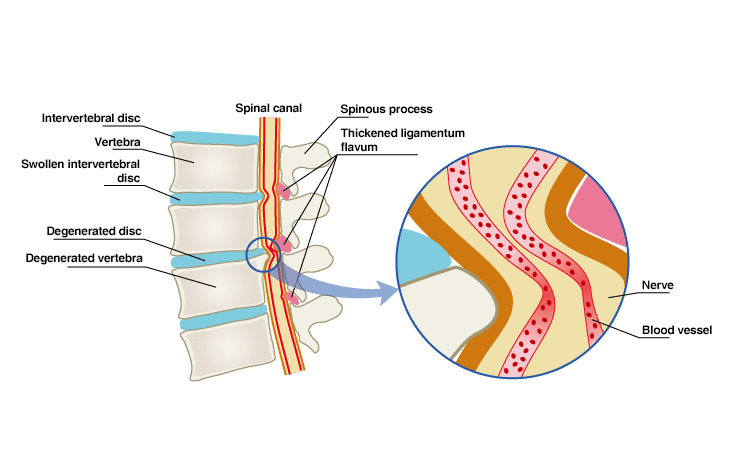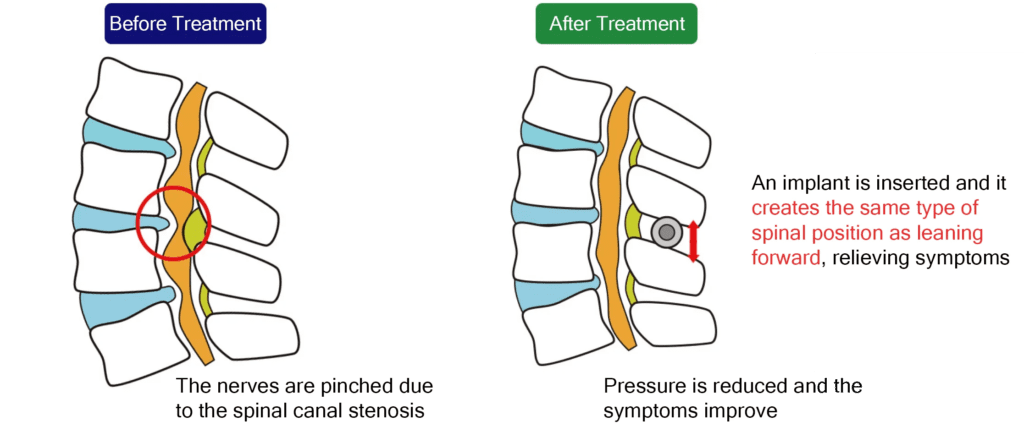Column Treatment of Spinal Canal Stenosis: A Comparison Between Surgery and Conservative Therapy
April 11, 2025
Spinal canal stenosis in the lower back is one of the most common spinal disorders in people in their 50s and older.
In this article, we will discuss the treatments available for spinal canal stenosis.
What is spinal canal stenosis?
Spinal canal stenosis is a condition in which the nerve pathways (i.e., the spinal canal) in the spine constrict.

The narrowing of the spinal canal causes the nerves to be compressed, resulting in pain in the lower back, pain and numbness in the lower extremities, pain and numbness in the buttocks, and abnormal sensations (or paresthesia).
One of the characteristic symptoms of lumbar spinal canal stenosis is intermittent claudication. This is a condition in which the patient feels pain and numbness in the legs when walking, but the patient regains some semblance of relief and can walk again after a short rest, only for the pain to return after a short time. Once you suffer from intermittent claudication, even just walking 100 to 500 meters can become difficult.
As spinal canal stenosis progresses, urinary and bowel problems may also occur.
Treatment of Scoliosis
Conservative Therapy
Conservative therapy for spinal stenosis includes medication and exercise therapy.
Medication includes anti-inflammatory and analgesic drugs as well as drugs that improve blood flow to the nerves to alleviate pain and other symptoms. Physical therapy involves rehabilitation, stretching, and strength training to improve back pain and alleviate lower limb pain.
・Benefits:
It is less stressful on the body and relatively inexpensive.
For the elderly or those with chronic illnesses, it eliminates the risk of general anesthesia and postoperative complications.
∙ Disadvantages:
Since the compression of the nerve proper is not removed, it does not provide a fundamental cure and therefore makes it difficult to completely eliminate the symptoms.
It may take several weeks to several months to achieve results.
If conservative treatment is not effective, symptoms may progress.
Surgery
If conservative treatment fails to improve the symptoms, or if the spinal canal stenosis progresses to the point where symptoms aggravate, and walking becomes difficult, surgical treatment may be considered.
The most common surgical procedures for spinal canal stenosis are lumbar laminectomy and spinal fusion.
Lumbar laminectomy is performed under general anesthesia while using an endoscope, and the skin of the back is cut open and part of the vertebral arch and thickened ligamentum flavum is removed to relieve nerve compression and widen the spinal canal.
Spinal fusion is performed under general anesthesia by making an incision in the skin of the back, removing the degenerated disc, and placing a cage filled with bone taken from the hip bone to hold the vertebrae in place with screws and rods. It may be performed subsequently to a lumbar laminectomy.

・Benefits:
By removing the bone and ligaments causing stenosis, the nerve pathways are widened and a fundamental improvement in the symptoms can be expected.
Improvement of quality of life (QOL) can also be expected.
Depending on the medical institution, health insurance may cover the procedure.
・Disadvantages:
Hospitalization is required for 1 to 2 weeks.
It takes time (several weeks to several months) to return to one’s regular activities following the surgery.
There are some risks of infection, bleeding, nerve damage, etc. Particular attention should be paid to the elderly and those with pre-existing medical conditions.
If the extent of the area removed is too small, symptoms may remain.
There is a possibility of recurrence. In some cases, the operated area may deteriorate again, or another area may develop stenosis.
If the spine becomes unstable after surgery, revision surgery (spinal fusion) will be performed.
The surgical technique requires skill, and only specialized hospitals can perform the surgery.
Minimally invasive procedures – the Florence method and Q-Florence method
In recent years, minimally invasive procedures for spinal canal stenosis have become available.
The Florence and Q-Florence procedures are minimally invasive, low-risk treatments for spinal stenosis and spondylolisthesis.
A device is percutaneously inserted under partial anesthesia and sedation to widen the narrowed spinal canal.
The device is inserted to stabilize the vertebrae while preserving spinal rotation and flexion, widening the spinal canal and reducing the protrusion of the intervertebral discs and ligamentum flavum thickening. Pain is eliminated as the narrowed spinal canal is widened.

・Benefits:
Less stress on the body as no major resection of muscle or bone is required. Even the elderly can undergo the treatment.
The procedure is performed under partial anesthesia and sedation, making it safe for the elderly and those with underlying medical conditions.
It can be done as a one-day treatment and does not require hospitalization. It allows for a quick return to work and daily activities.
Unlike spinal fusion, there are no limitations put on spinal mobility after the procedure.
Unlike surgery for spinal stenosis, the recurrence rate is extremely low.
Inserted devices can be safely removed until a certain period after insertion
・Disadvantages:
Depending on the cause of spinal stenosis, treatment may be less effective or not indicated.
Severe spondylolisthesis is a contra-indication for this procedure.
The Florence and Q-Florence methods available in Japan are not covered by health insurance and must be paid entirely out-of-pocket.
The Q Florence Method (page in Japanese)
If you have previously been diagnosed with spinal canal stenosis, please consider a consultation at our clinic.
Related Articles
The Different Symptoms of Spinal Canal Stenosis: If You Have Any of These, It’s a Red Flag!
Is it already too late! ? What should I do about spinal canal stenosis that has been left untreated?
What are the Various Complications Possible With Spinal Stenosis?
Why Do the Symptoms of Spinal Stenosis Differ From Person to Person?
Diagnosis and Treatment of Spinal Stenosis: Why Early Detection is Critical
How to Prevent Spinal Canal Stenosis: Things to Implement in Your Daily Activity Routine



